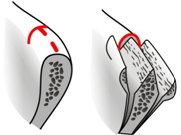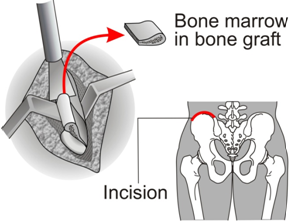|
|
Uses of Bone Grafts
- To fill cavities e.g. Cysts
- To bridge joints - arthrodesis
- To bridge major defects and restore continuity of a long bone
- To provide a bone block and limit joint motion (arthrodesis)
- To promote union in a pseudoarthrosis (nonunion)
- To promote union in delayed union , non union or fresh fractures
or osteotomies.
Functions of Bone Grafts
- Mechanical Strength - to immobilise a bone cortical
graft e.g. an intact fibula can be used.
- Ostogenesis- marrow bone such as bone removed from the pelvis.
e.g. delayed union of a tibial fracture. This is laid about he fracture
gap.
- Replacement - loss of a section of long bone may be bridged
by bone graft. .If the gap is significant a vascurarised graft
is indicated.
Terminology
- Autografts Transposition of bone tissue from one site to
an other in the same individual
- Allograft Use of grafts between different individuals
of the same species. Use is made of a bone bank that stores the
bone harvested from cadavers or femoral heads from hip replacements.
The bone is preserved by freeze drying or irradiation. This
bone has poorer osteogenic potential than allografts.
- Xenograft Transplantation from an individual of one species
to another of a different species.
| 
|
| Harvest from the anterior Crista
Iliaca |
Donor Site Complications - Pelvis
- Fracture e.g. Sartorius fractures off SIAS
- Hernia - through pelvic defect
- Nerve damage e.g. lat. cutaneous of thigh
- Pain
| 
|
Posterior pelvic bone graft.
Useful in spinal surgery. More bone can be obtained than anteriorly
|
|